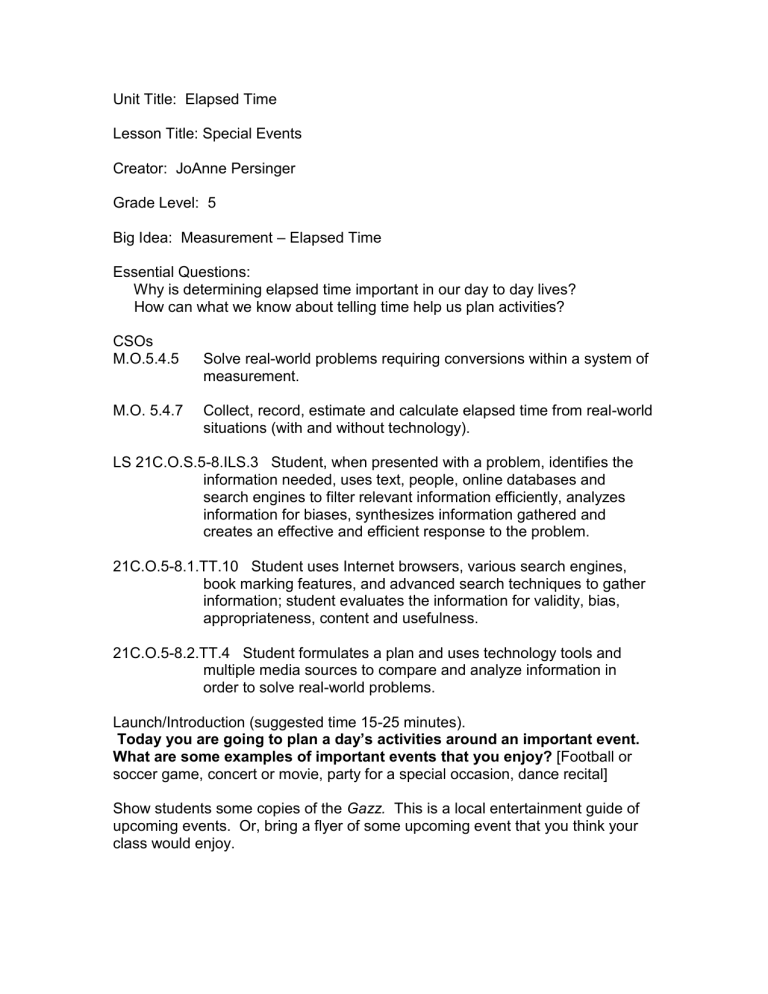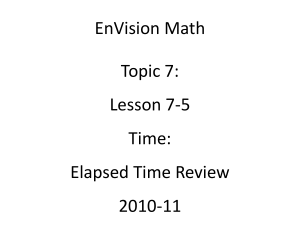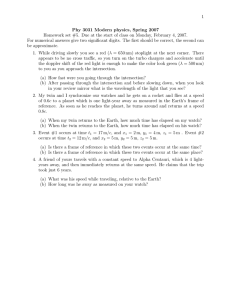Unit Title: Elapsed Time Lesson Title: Special Events

Unit Title: Elapsed Time
Lesson Title: Special Events
Creator: JoAnne Persinger
Grade Level: 5
Big Idea: Measurement – Elapsed Time
Essential Questions:
Why is determining elapsed time important in our day to day lives?
How can what we know about telling time help us plan activities?
CSOs
M.O.5.4.5 Solve real-world problems requiring conversions within a system of measurement.
M.O. 5.4.7 Collect, record, estimate and calculate elapsed time from real-world situations (with and without technology).
LS 21C.O.S.5-8.ILS.3 Student, when presented with a problem, identifies the information needed, uses text, people, online databases and search engines to filter relevant information efficiently, analyzes information for biases, synthesizes information gathered and creates an effective and efficient response to the problem.
21C.O.5-8.1.TT.10 Student uses Internet browsers, various search engines, book marking features, and advanced search techniques to gather information; student evaluates the information for validity, bias, appropriateness, content and usefulness.
21C.O.5-8.2.TT.4 Student formulates a plan and uses technology tools and multiple media sources to compare and analyze information in order to solve real-world problems.
Launch/Introduction (suggested time 15-25 minutes).
Today you are going to plan a day’s activities around an important event.
What are some examples of important events that you enjoy?
[Football or soccer game, concert or movie, party for a special occasion, dance recital]
Show students some copies of the Gazz.
This is a local entertainment guide of upcoming events. Or, bring a flyer of some upcoming event that you think your class would enjoy.
What happens if you don’t arrive on time?
[Miss the event, come in late, can’t attend at all]
How can we make sure that doesn’t happen?
[Plan our day]
What are some of your everyday activities?
[Getting up, eating, showering, traveling, playing, going to school, doing homework, etc.]
Activating Prior Knowledge
Before we begin let’s review a little bit.
What do we call the difference between two times?
[Elapsed time]
How can we figure this?
[Subtract the ending time from the beginning time]
Is there another way? [For some people it is easier to count forward from the
beginning time until the ending time]
Emphasize at this time. Starting time + elapsed time = ending time
Ending time – elapsed time = starting time
[Put on the board.] Is 8:30 PM minus 1:20PM equal to 7:10PM?
[No.] Have student explain his thinking.
If our concert began at 8:00 PM and it took us one hour and fifteen minutes to get there, how would we decide what time we would have to leave?
[Have st udent demonstrate. Watch for those who don’t realize that your regrouping involves changing an hour to 60 minutes not 100 minutes. This might be a good time to review how to write time. [
3:10 doesn’t mean three hours and 10 minutes; it means 10 minutes a fter 3 o’clock. We must write it out as three hours and 10 minutes if that’s what we mean.]
Investigate/Explore (suggested time varies from 30 – 40 minutes)
Your mission today is to work with a partner and determine an important event that you will attend. You are going to use the starting time of that event and work backwards and tell me what activities you will do during the day, what time you will begin and end those activities, and the elapsed time for those activities. Then you will take the starting time of your event and tell how long it will last, what activities you will do after the event, what time you will begin and end those activities, and the elapsed time for those activities until you go to bed that night.
After you have finished I want you to take the beginning time for your day and the ending time of your day and tell us the elapsed time for the entire day. Record your activities on poster board. Be prepared to report to the class about your day, how you determined how long the activities would take, what affected your times, when you were able to estimate and when exact answers were needed.
At this time have a student repeat what each pair of students is to do. Answer any questions. Post the chart paper with the mission.
Specialized Vocabulary Development
Students have dealt with the term elapsed time before now. There would not be any specialized development other than reviewing the meaning and working through a few examples as seen in activating prior knowledge.
Elapsed time- the difference between the starting and the ending time of an event.
(This will be posted on chart paper and hanging in the classroom.)
It may be necessary at this point to work with a small group of students that are still struggling with elapsed time and let the others get started. Provide the attached task sheet as a starting point to help these students and make sure they are on the right track.
The students will begin researching their event and the starting time. They will discuss what other activities will be done during the day, estimating the amount of time activities will take, and figuring the elapsed times. Students may need to do a web search to find out travel time (map quest), special events and the length of time for those events, and other information that they might need to know.
Summarize/Debrief the Lesson (suggested time varies from 30-40 minutes)
The students will report to the rest of the class about their posters. This should show their event and the activities they did during the day. They will report how they figured out the elapsed time and what else they discovered as they planned their day. Students will tell the class when they had to know the exact times and when estimates were all that was needed. Hopefully, this will show the class the thoughts of other students and allow students to develop further understanding of the idea of elapsed time, why we figure elapsed time, and other factors that can interfere with our planning and established times. This will also provide the teacher an opportunity to question students to further clarify their thinking and review the essential questions.
How do you know that the elapsed time is ______?
What strategy did you use to figure that out?
Can you model that strategy?
Why is it important to know how much time has passed?
Is your travel time estimate reasonable?
Materials: classroom computers, individual clocks, clock faces, the class mission posted on chart paper, definition of elapsed time also posted on chart paper, entertainment guides from the newspaper, task sheets, and poster board
Duration: two sixty minute class periods
Discussion:
At the fifth grade level students are still struggling with elapsed time. When I started to search through different math series at the fifth grade level I could not
find anything on elapsed time. Students are expected to be comfortable with this idea because they use the clock as a context for number stories, investigations and other problem-solving situations. For adults clock time is a reference frame with second, minute, and hour intervals that seem logical. This is a confusing concept for many students and they need time to practice this. If your school has
Odyssey on your computers lessons 6435 and 5436 can provide additional practice for your students.
Precursors for students to be successful with this objective are that students must be able to tell time at the five minute intervals, use relationships between minutes, hours, days, weeks, months, and years to describe time, and be able to subtract 2- and 3- digit numbers with regrouping.
It is important when calculating elapsed time by subtraction, to watch for students who may attempt to regroup in the same manner as with subtraction of whole numbers. You may need to remind students that for every hour borrowed, they must add 60 minutes to the minute’s column. For some students it is just as easy to count forward from the starting time until you reach the ending time. It is also important for students to check for reasonableness of their answers when solving each problem.






